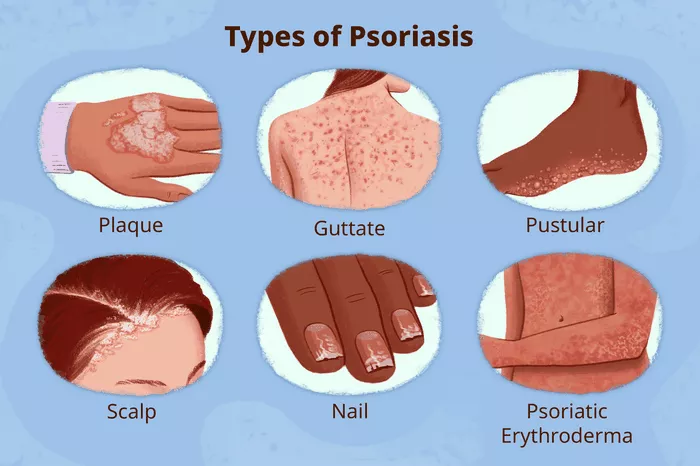Psoriasis is a chronic autoimmune disorder that affects the skin, causing a range of distinctive and often uncomfortable symptoms. Characterized by the rapid buildup of skin cells, psoriasis can present in various forms and locations on the body. Understanding the visual manifestations of this condition is crucial for both individuals living with psoriasis and those seeking to support them.
The Diversity of Psoriasis Plaques
One of the hallmark features of psoriasis is the presence of plaques – raised, red patches covered with a silvery-white buildup of dead skin cells. These plaques can vary widely in size and shape, ranging from small, localized patches to larger areas that may cover significant portions of the body. The elbows, knees, and scalp are common sites for plaque formation, though they can appear anywhere on the skin surface.
Guttate Psoriasis: Small Yet Impactful
Guttate psoriasis is a unique variant characterized by small, drop-like lesions scattered across the skin. These lesions are often smaller than the plaques associated with other forms of psoriasis, creating a distinctive appearance. Guttate psoriasis is frequently triggered by infections, such as streptococcal throat infections, making it crucial to address underlying health issues in managing this particular presentation of the condition.
Inverse Psoriasis: Unseen Challenges
While many associate psoriasis with visible skin plaques, inverse psoriasis presents differently. This form of psoriasis appears as smooth, red, inflamed lesions in skin folds, such as the armpits, groin, and beneath the breasts. Because of its location, inverse psoriasis can be particularly challenging for those affected, causing discomfort and sensitivity in areas where skin rubs against skin. Proper recognition of this variant is essential for accurate diagnosis and targeted treatment.
Pustular Psoriasis: Beyond Plaques
In some cases, psoriasis can take on a more severe and distinctive form known as pustular psoriasis. This variant is characterized by the presence of pus-filled blisters on the skin, often accompanied by redness and scaling. Pustular psoriasis can be localized to specific areas of the body or affect the entire surface, requiring specialized medical attention. Understanding the unique appearance of pustular psoriasis is crucial for prompt diagnosis and appropriate management.
Nail Psoriasis: Clues in Your Fingertips
Psoriasis can extend beyond the skin, affecting the nails in a condition known as nail psoriasis. Changes in the nails can include pitting (small dents or depressions), discoloration, and separation of the nail from the nail bed. Recognizing these subtle yet significant signs is essential, as nail psoriasis can contribute to functional impairment and impact the overall quality of life for individuals with psoriasis.
Scalp Psoriasis: Hidden Challenges
The scalp is a common site for psoriasis flare-ups, leading to a condition known as scalp psoriasis. This manifestation can range from mild dandruff-like scaling to more severe redness and plaques that extend beyond the hairline. Managing scalp psoriasis requires specialized attention, and understanding its appearance is vital for both individuals with psoriasis and healthcare professionals.
Psoriatic Arthritis: A Dual Challenge
Beyond the visible skin manifestations, psoriasis can also affect the joints, leading to a condition known as psoriatic arthritis. This dual challenge combines the skin symptoms of psoriasis with joint pain, swelling, and stiffness. Recognizing the signs of psoriatic arthritis early on is crucial for initiating appropriate treatment and preventing long-term joint damage.
Impact on Quality of Life
The visible symptoms of psoriasis extend beyond the physical appearance, profoundly impacting the emotional and psychological well-being of individuals affected. The societal stigma associated with visible skin conditions can lead to feelings of self-consciousness and isolation. Understanding and addressing the holistic impact of psoriasis on an individual’s quality of life is integral to providing comprehensive care.
Seeking Professional Guidance
Given the diverse manifestations of psoriasis, seeking professional medical guidance is essential for accurate diagnosis and effective management. Dermatologists play a crucial role in identifying the specific type of psoriasis based on its appearance, considering factors such as location, size, and associated symptoms.
Holistic Approach to Psoriasis Management
While there is no cure for psoriasis, various treatment options exist to manage symptoms and improve quality of life. These may include topical medications, phototherapy, oral medications, and biologic drugs. Additionally, lifestyle factors such as stress management, a healthy diet, and avoiding triggers can contribute to overall well-being.
Conclusion
Psoriasis is a complex and multifaceted condition with diverse visual manifestations. Recognizing the varied appearances of psoriasis is crucial for accurate diagnosis, effective treatment, and holistic support for individuals living with this chronic condition. By fostering awareness and understanding, we can contribute to a more supportive and inclusive environment for those navigating the visible challenges of psoriasis.

























